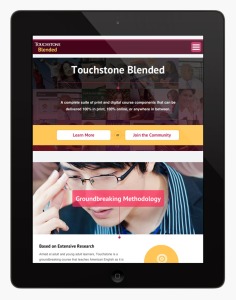Back in the middle of the last century, the first interactive machines for language teaching appeared. Previously, there had been phonograph discs and wire recorders (Ornstein, 1968: 401), but these had never really taken off. This time, things were different. Buoyed by a belief in the power of technology, along with the need (following the Soviet Union’s successful Sputnik programme) to demonstrate the pre-eminence of the United States’ technological expertise, the interactive teaching machines that were used in programmed instruction promised to revolutionize language learning (Valdman, 1968: 1). From coast to coast, ‘tremors of excitement ran through professional journals and conferences and department meetings’ (Kennedy, 1967: 871). The new technology was driven by hard science, supported and promoted by the one of the most well-known and respected psychologists and public intellectuals of the day (Skinner, 1961).
In classrooms, the machines acted as powerfully effective triggers in generating situational interest (Hidi & Renninger, 2006). Even more exciting than the mechanical teaching machines were the computers that were appearing on the scene. ‘Lick’ Licklider, a pioneer in interactive computing at the Advanced Research Projects Agency in Arlington, Virginia, developed an automated drill routine for learning German by hooking up a computer, two typewriters, an oscilloscope and a light pen (Noble, 1991: 124). Students loved it, and some would ‘go on and on, learning German words until they were forced by scheduling to cease their efforts’. Researchers called the seductive nature of the technology ‘stimulus trapping’, and Licklider hoped that ‘before [the student] gets out from under the control of the computer’s incentives, [they] will learn enough German words’ (Noble, 1991: 125).
With many of the developed economies of the world facing a critical shortage of teachers, ‘an urgent pedagogical emergency’ (Hof, 2018), the new approach was considered to be extremely efficient and could equalise opportunity in schools across the country. It was ‘here to stay: [it] appears destined to make progress that could well go beyond the fondest dreams of its originators […] an entire industry is just coming into being and significant sales and profits should not be too long in coming’ (Kozlowski, 1961: 47).
Unfortunately, however, researchers and entrepreneurs had massively underestimated the significance of novelty effects. The triggered situational interest of the machines did not lead to intrinsic individual motivation. Students quickly tired of, and eventually came to dislike, programmed instruction and the machines that delivered it (McDonald et al.: 2005: 89). What’s more, the machines were expensive and ‘research studies conducted on its effectiveness showed that the differences in achievement did not constantly or substantially favour programmed instruction over conventional instruction (Saettler, 2004: 303). Newer technologies, with better ‘stimulus trapping’, were appearing. Programmed instruction lost its backing and disappeared, leaving as traces only its interest in clearly defined learning objectives, the measurement of learning outcomes and a concern with the efficiency of learning approaches.
Hot on the heels of programmed instruction came the language laboratory. Futuristic in appearance, not entirely unlike the deck of the starship USS Enterprise which launched at around the same time, language labs captured the public imagination and promised to explore the final frontiers of language learning. As with the earlier teaching machines, students were initially enthusiastic. Even today, when language labs are introduced into contexts where they may be perceived as new technology, they can lead to high levels of initial motivation (e.g. Ramganesh & Janaki, 2017).
Given the huge investments into these labs, it’s unfortunate that initial interest waned fast. By 1969, many of these rooms had turned into ‘“electronic graveyards,” sitting empty and unused, or perhaps somewhat glorified study halls to which students grudgingly repair to don headphones, turn down the volume, and prepare the next period’s history or English lesson, unmolested by any member of the foreign language faculty’ (Turner, 1969: 1, quoted in Roby, 2003: 527). ‘Many second language students shudder[ed] at the thought of entering into the bowels of the “language laboratory” to practice and perfect the acoustical aerobics of proper pronunciation skills. Visions of sterile white-walled, windowless rooms, filled with endless bolted-down rows of claustrophobic metal carrels, and overseen by a humorless, lab director, evoke[d] fear in the hearts of even the most stout-hearted prospective second-language learners (Wiley, 1990: 44).
By the turn of this century, language labs had mostly gone, consigned to oblivion by the appearance of yet newer technology: the internet, laptops and smartphones. Education had been on the brink of being transformed through new learning technologies for decades (Laurillard, 2008: 1), but this time it really was different. It wasn’t just one technology that had appeared, but a whole slew of them: ‘artificial intelligence, learning analytics, predictive analytics, adaptive learning software, school management software, learning management systems (LMS), school clouds. No school was without these and other technologies branded as ‘superintelligent’ by the late 2020s’ (Macgilchrist et al., 2019). The hardware, especially phones, was ubiquitous and, therefore, free. Unlike teaching machines and language laboratories, students were used to using the technology and expected to use their devices in their studies.
A barrage of publicity, mostly paid for by the industry, surrounded the new technologies. These would ‘meet the demands of Generation Z’, the new generation of students, now cast as consumers, who ‘were accustomed to personalizing everything’. AR, VR, interactive whiteboards, digital projectors and so on made it easier to ‘create engaging, interactive experiences’. The ‘New Age’ technologies made learning fun and easy, ‘bringing enthusiasm among the students, improving student engagement, enriching the teaching process, and bringing liveliness in the classroom’. On top of that, they allowed huge amounts of data to be captured and sold, whilst tracking progress and attendance. In any case, resistance to digital technology, said more than one language teaching expert, was pointless (Styring, 2015).
At the same time, technology companies increasingly took on ‘central roles as advisors to national governments and local districts on educational futures’ and public educational institutions came to be ‘regarded by many as dispensable or even harmful’ (Macgilchrist et al., 2019).
But, as it turned out, the students of Generation Z were not as uniformly enthusiastic about the new technology as had been assumed, and resistance to digital, personalized delivery in education was not long in coming. In November 2018, high school students at Brooklyn’s Secondary School for Journalism staged a walkout in protest at their school’s use of Summit Learning, a web-based platform promoting personalized learning developed by Facebook. They complained that the platform resulted in coursework requiring students to spend much of their day in front of a computer screen, that made it easy to cheat by looking up answers online, and that some of their teachers didn’t have the proper training for the curriculum (Leskin, 2018). Besides, their school was in a deplorable state of disrepair, especially the toilets. There were similar protests in Kansas, where students staged sit-ins, supported by their parents, one of whom complained that ‘we’re allowing the computers to teach and the kids all looked like zombies’ before pulling his son out of the school (Bowles, 2019). In Pennsylvania and Connecticut, some schools stopped using Summit Learning altogether, following protests.
But the resistance did not last. Protesters were accused of being nostalgic conservatives and educationalists kept largely quiet, fearful of losing their funding from the Chan Zuckerberg Initiative (Facebook) and other philanthro-capitalists. The provision of training in grit, growth mindset, positive psychology and mindfulness (also promoted by the technology companies) was ramped up, and eventually the disaffected students became more quiescent. Before long, the data-intensive, personalized approach, relying on the tools, services and data storage of particular platforms had become ‘baked in’ to educational systems around the world (Moore, 2018: 211). There was no going back (except for small numbers of ultra-privileged students in a few private institutions).
By the middle of the century (2155), most students, of all ages, studied with interactive screens in the comfort of their homes. Algorithmically-driven content, with personalized, adaptive tests had become the norm, but the technology occasionally went wrong, leading to some frustration. One day, two young children discovered a book in their attic. Made of paper with yellow, crinkly pages, where ‘the words stood still instead of moving the way they were supposed to’. The book recounted the experience of schools in the distant past, where ‘all the kids from the neighbourhood came’, sitting in the same room with a human teacher, studying the same things ‘so they could help one another on the homework and talk about it’. Margie, the younger of the children at 11 years old, was engrossed in the book when she received a nudge from her personalized learning platform to return to her studies. But Margie was reluctant to go back to her fractions. She ‘was thinking about how the kids must have loved it in the old days. She was thinking about the fun they had’ (Asimov, 1951).
References
Asimov, I. 1951. The Fun They Had. Accessed September 20, 2019. http://web1.nbed.nb.ca/sites/ASD-S/1820/J%20Johnston/Isaac%20Asimov%20-%20The%20fun%20they%20had.pdf
Bowles, N. 2019. ‘Silicon Valley Came to Kansas Schools. That Started a Rebellion’ The New York Times, April 21. Accessed September 20, 2019. https://www.nytimes.com/2019/04/21/technology/silicon-valley-kansas-schools.html
Hidi, S. & Renninger, K.A. 2006. ‘The Four-Phase Model of Interest Development’ Educational Psychologist, 41 (2), 111 – 127
Hof, B. 2018. ‘From Harvard via Moscow to West Berlin: educational technology, programmed instruction and the commercialisation of learning after 1957’ History of Education, 47 (4): 445-465
Kennedy, R.H. 1967. ‘Before using Programmed Instruction’ The English Journal, 56 (6), 871 – 873
Kozlowski, T. 1961. ‘Programmed Teaching’ Financial Analysts Journal, 17 (6): 47 – 54
Laurillard, D. 2008. Digital Technologies and their Role in Achieving our Ambitions for Education. London: Institute for Education.
Leskin, P. 2018. ‘Students in Brooklyn protest their school’s use of a Zuckerberg-backed online curriculum that Facebook engineers helped build’ Business Insider, 12.11.18 Accessed 20 September 2019. https://www.businessinsider.de/summit-learning-school-curriculum-funded-by-zuckerberg-faces-backlash-brooklyn-2018-11?r=US&IR=T
McDonald, J. K., Yanchar, S. C. & Osguthorpe, R.T. 2005. ‘Learning from Programmed Instruction: Examining Implications for Modern Instructional Technology’ Educational Technology Research and Development, 53 (2): 84 – 98
Macgilchrist, F., Allert, H. & Bruch, A. 2019. ‚Students and society in the 2020s. Three future ‘histories’ of education and technology’. Learning, Media and Technology, https://www.tandfonline.com/doi/full/10.1080/17439884.2019.1656235 )
Moore, M. 2018. Democracy Hacked. London: Oneworld
Noble, D. D. 1991. The Classroom Arsenal. London: The Falmer Press
Ornstein, J. 1968. ‘Programmed Instruction and Educational Technology in the Language Field: Boon or Failure?’ The Modern Language Journal, 52 (7), 401 – 410
Ramganesh, E. & Janaki, S. 2017. ‘Attitude of College Teachers towards the Utilization of Language Laboratories for Learning English’ Asian Journal of Social Science Studies; Vol. 2 (1): 103 – 109
Roby, W.B. 2003. ‘Technology in the service of foreign language teaching: The case of the language laboratory’ In D. Jonassen (ed.), Handbook of Research on Educational Communications and Technology, 2nd ed.: 523 – 541. Mahwah, NJ.: Lawrence Erlbaum Associates
Saettler, P. 2004. The Evolution of American Educational Technology. Greenwich, Conn.: Information Age Publishing
Skinner, B. F. 1961. ‘Teaching Machines’ Scientific American, 205(5), 90-107
Styring, J. 2015. Engaging Generation Z. Cambridge English webinar 2015 https://www.youtube.com/watch?time_continue=4&v=XCxl4TqgQZA
Valdman, A. 1968. ‘Programmed Instruction versus Guided Learning in Foreign Language Acquisition’ Die Unterrichtspraxis / Teaching German, 1 (2), 1 – 14.
Wiley, P. D. 1990. ‘Language labs for 1990: User-friendly, expandable and affordable’. Media & Methods, 27(1), 44–47)

Jenny Holzer, Protect me from what I want
